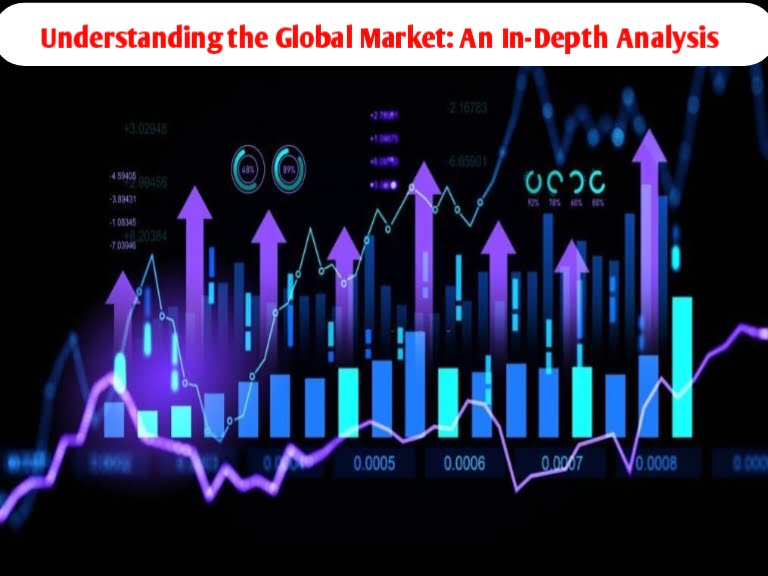Understanding the Global Market: An In-Depth Analysis
Understanding the Global Market:
The global market refers to the interconnected network of economic activities and exchanges that span across countries and continents. It encompasses the trade of goods and services, financial markets, and the movement of capital and labor. Here, we provide a comprehensive overview of the global market, its key components, dynamics, and the factors influencing its operations.
Key Components of the Global Market
- International Trade
- Goods and Services: The exchange of physical goods (such as electronics, vehicles, and clothing) and services (such as finance, tourism, and information technology) between countries.
- Trade Agreements: Bilateral and multilateral agreements that facilitate trade by reducing tariffs, quotas, and other barriers. Examples include NAFTA (now USMCA), the European Union, and the Trans-Pacific Partnership (TPP).
- Financial Markets
- Stock Markets: Platforms where shares of publicly traded companies are bought and sold. Major stock exchanges include the New York Stock Exchange (NYSE), Tokyo Stock Exchange (TSE), and London Stock Exchange (LSE).
- Currency Markets: The foreign exchange (Forex) market where currencies are traded. It plays a crucial role in global trade and investment.
- Bond Markets: Markets where governments and corporations issue debt to investors. They are essential for funding public projects and corporate expansions.
- Capital Flows
- Foreign Direct Investment (FDI): Investments made by a company or individual in one country into business interests in another country. FDI can take the form of building new facilities, mergers, or acquisitions.
- Portfolio Investment: Investments in foreign financial assets, such as stocks and bonds, without acquiring a significant degree of control over the companies.
- Labor Movement
- Migration: The movement of workers across borders in search of better employment opportunities. It includes both skilled and unskilled labor migration.
- Remittances: Money sent by migrants to their home countries, which is a significant source of income for many developing economies.
Dynamics of the Global Market
Reading more… Artistic Swimming at the Olympics: A Comprehensive Overview
- Globalization
- Integration: Increased interconnectedness and interdependence of world economies, driven by advancements in technology, transportation, and communication.
- Impact on Businesses: Globalization allows businesses to expand their markets, access a larger talent pool, and optimize supply chains. However, it also introduces challenges such as increased competition and vulnerability to global economic fluctuations.
- Economic Policies
- Monetary Policy: Central banks’ actions, such as setting interest rates and controlling money supply, influence global financial stability and capital flows.
- Fiscal Policy: Government spending and taxation decisions impact economic growth, employment, and inflation.
- Technological Advancements
- E-commerce: Online platforms have revolutionized retail, allowing businesses to reach global customers.
- Digital Currency: Cryptocurrencies and blockchain technology are reshaping financial transactions and investment strategies.
- Geopolitical Factors
- Trade Wars: Tariff disputes and trade barriers between major economies can disrupt global trade patterns and economic stability.
- Political Stability: Stable political environments attract foreign investments, while political unrest can deter investment and economic growth.
Challenges and Opportunities
- Challenges
- Economic Disparities: Unequal distribution of wealth and resources between countries can lead to economic imbalances and social unrest.
- Environmental Concerns: Global trade and industrial activities contribute to environmental degradation and climate change.
- Regulatory Differences: Navigating diverse regulatory environments can be complex for multinational companies.
- Opportunities
- Emerging Markets: Rapid economic growth in countries like China, India, and Brazil presents significant opportunities for investment and expansion.
- Innovation: Technological advancements offer new business models, products, and services.
- Sustainable Practices: Growing awareness of environmental and social issues drives demand for sustainable and ethical business practices.
Conclusion
The global market is a dynamic and complex system that plays a crucial role in shaping the world’s economic landscape. Understanding its components, dynamics, challenges, and opportunities is essential for businesses, policymakers, and investors to navigate and thrive in this interconnected economy. As globalization continues to evolve, the global market will remain a pivotal force in driving economic growth, innovation, and development.
How did you like the information given in our article today, please tell us in the comment section and for more such posts, follow our page The News House, thank you

